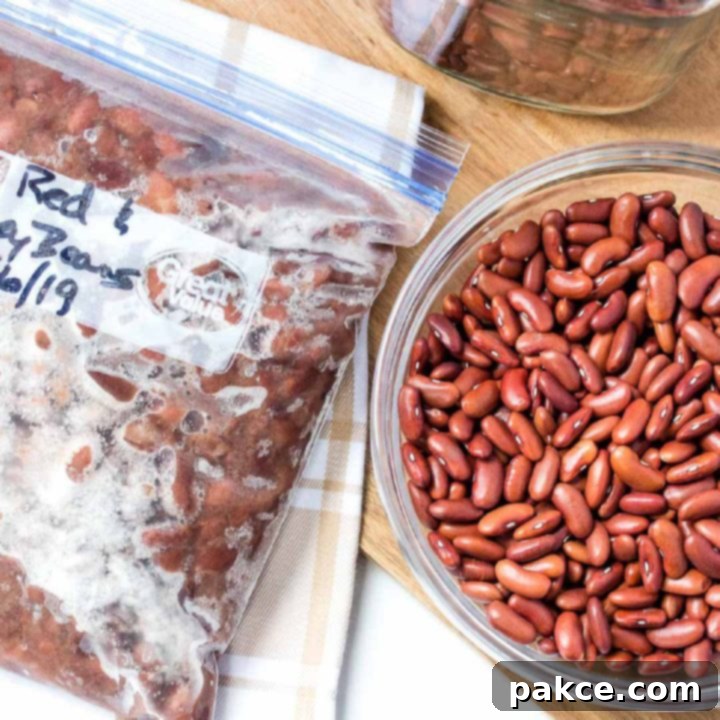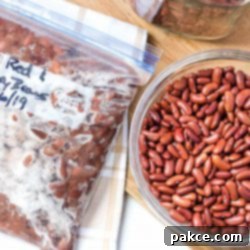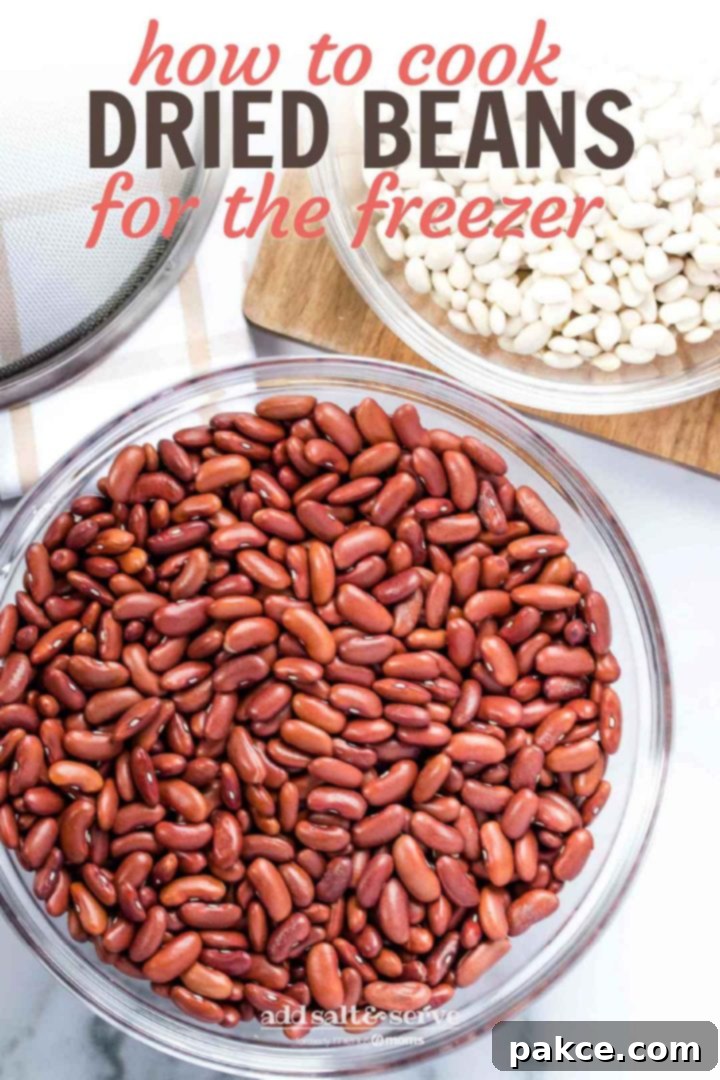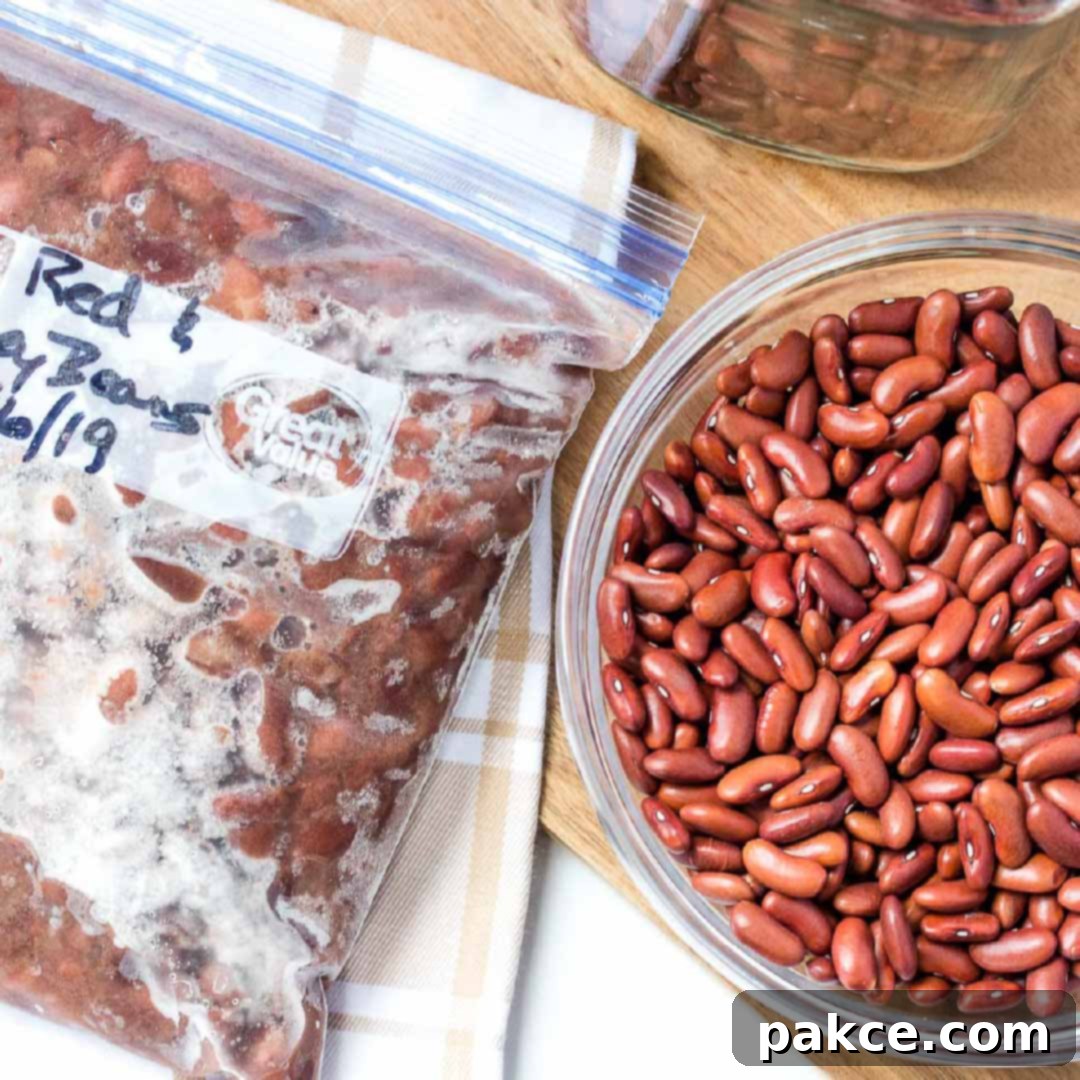Mastering Dried Beans: Your Ultimate Guide to Cooking, Freezing & Saving Money
Are you looking for an effortless way to save money on groceries while also boosting the nutritional value of your meals? Look no further than dried beans! Swapping canned beans for their dried counterparts is a simple yet impactful change that can cut your costs by as much as 50% per serving. While the idea of cooking dried beans from scratch might seem daunting due to the time commitment, the actual hands-on effort is minimal, often requiring only a few quick checks over several hours. This comprehensive guide will walk you through everything you need to know about cooking dried beans, preparing them for the freezer, and integrating them seamlessly into your weekly meal plans.
For those following our meal plans or simply aiming for efficient meal prep, cooking a large batch (one or two bags, depending on your pot size) of dried beans and freezing them in convenient 2-cup portions is a game-changer. Each 2-cup bag of frozen beans can be used directly in place of a standard 15-ounce can of beans, offering incredible versatility and convenience on busy weeknights.

Why Choose Dried Beans Over Canned?
The benefits of cooking dried beans go far beyond just saving money, although that’s a significant perk! Here’s a closer look at why they are a superior choice:
- Cost-Effective: As mentioned, dried beans are significantly cheaper. Imagine halving your bean-related grocery expenses over time! This adds up, especially when incorporating beans into multiple meals a week.
- Superior Flavor and Texture: Canned beans often have a metallic taste and a softer, sometimes mushy texture. When you cook dried beans, you have complete control over the doneness, resulting in a firm yet creamy texture and a rich, earthy flavor that canned beans simply can’t match.
- Reduced Sodium: Canned beans are notorious for their high sodium content, even “low sodium” varieties. Cooking dried beans allows you to control the exact amount of salt, if any, you add, making them a much healthier option for those monitoring their sodium intake.
- Nutritional Powerhouse: Beans are packed with fiber, plant-based protein, and essential vitamins and minerals like iron, folate, magnesium, and potassium. Cooking them from scratch preserves more of these nutrients and avoids any potential additives found in canned versions.
- Environmental Impact: Choosing dried beans reduces your consumption of single-use cans, contributing to less waste and a smaller carbon footprint.
- Versatility: Once cooked, homemade beans are incredibly versatile. Use them in soups, stews, chilis, salads, dips, burritos, and more. The possibilities are endless!
Popular Types of Dried Beans and Their Uses
The world of dried beans is wonderfully diverse! Each type offers unique flavors and textures, making them suitable for different dishes. Here are a few common varieties you might want to cook and freeze:
- Pinto Beans: Creamy texture, mild flavor. Perfect for refried beans, burritos, chili, or served simply over cornbread with chopped onion and shredded cheddar cheese. (As noted in the original content: Pinto beans cooked with chopped onion (1-½ onions per pound of beans) are delicious served over cornbread with chopped onion and shredded cheddar cheese on top. Season the beans to taste with salt and pepper after cooking is complete.)
- Black Beans: Earthy flavor, soft texture. A staple in Latin American and Caribbean cuisine. Great for black bean soup, tacos, salads, and rice dishes.
- Kidney Beans: Robust flavor, firm texture. Essential for chili, salads, and red beans and rice.
- Great Northern Beans: Mild flavor, slightly firmer than cannellini. Ideal for white bean chili, soups, and casseroles.
- Navy Beans: Small, oval, and very mild. Fantastic for baked beans, bean purees, and creamy soups.
- Cannellini Beans (White Kidney Beans): Large, creamy white beans with a nutty flavor. Excellent in Italian dishes, salads, and minestrone.
- Chickpeas (Garbanzo Beans): Nutty flavor, firm texture. The star of hummus, falafel, roasted snacks, and many Mediterranean and Indian dishes.
The Importance of Soaking Beans
Soaking dried beans is a crucial step that offers several advantages:
- Reduces Cooking Time: Soaking allows beans to absorb water, which significantly shortens their cooking time.
- Improves Texture: Properly soaked beans cook more evenly, resulting in a creamier, more consistent texture.
- Aids Digestion: Soaking helps break down complex sugars that can cause digestive discomfort (gas) for some people. Rinsing the beans and using fresh water for cooking further minimizes this.
Soaking Methods:
There are two main ways to soak dried beans:
- Traditional Overnight Soak: This is the most common method. Place your rinsed beans in a large pot and cover them with water, ensuring the water level is at least two inches above the beans (as they will expand significantly). Let them soak at room temperature for at least 8 hours or overnight.
- Quick Soak Method: If you’re short on time, the quick soak method is your friend. After rinsing, place beans in a large pot and cover them with water (again, about two inches above the beans). Bring the water to a boil, then boil for 2-3 minutes. Remove from heat, cover the pot, and let the beans stand for 1-2 hours.
Regardless of the method, always drain and rinse the soaked beans thoroughly before cooking. This helps remove the indigestible sugars that can cause gas.
Recipe: How To Cook Dried Beans for the Freezer

How To Cook Dried Beans for the Freezer
Go to Collections
Add to Shopping List
Go to Shopping List
Ingredients
- 1 lb. bag dried beans, choose your favorite: black, pinto, kidney, great northern, cannellini, navy, etc.
- Water (for soaking and cooking)
- Salt and Pepper (to taste, added after cooking)
- Optional aromatics: 1-2 chopped onions, garlic cloves, bay leaves, or other spices for flavor.
Instructions
-
Prepare the Beans: Begin by carefully rinsing your chosen dried beans in a colander under cool running water. As you rinse, visually inspect the beans for any small stones, damaged beans, or other debris and discard them. This sorting step is essential for quality control.
Once clean, place the beans in a large pot. Add water so that the beans are covered by at least two inches of water. This ensures they have ample room to expand during the soaking process. Let the beans soak for a minimum of 5 hours, ideally overnight (8-12 hours) at room temperature. For a quick soak, bring the beans and water to a boil for 2-3 minutes, then remove from heat, cover, and let stand for 1-2 hours. -
Cook the Beans (Stovetop or Instant Pot):
Stovetop Method: After soaking, drain the beans completely in a colander and thoroughly rinse the pot. Return the rinsed beans to the cleaned pot. Add fresh water, again ensuring the beans are covered by at least two inches. If using, you can add aromatics like chopped onion, garlic cloves, or a bay leaf at this stage for added flavor, but hold off on adding salt until the beans are cooked through (salt can toughen beans if added too early). Bring the water to a boil, then reduce the heat to a gentle simmer. Cook until the beans are tender. The cooking time can vary significantly, ranging from 45 minutes to 2 hours, depending on the type and age of the beans. Check for tenderness by pressing a bean between your fingers or tasting it. They should be soft but not mushy.
Instant Pot/Pressure Cooker Method: For a faster cooking time, an Instant Pot or pressure cooker is an excellent option. Consult the manufacturer’s cooking time guidelines for dried beans (e.g., Instant Pot’s website). It’s crucial to be mindful of liquid levels, as beans tend to foam during pressure cooking. The inner pot should never be more than half full with beans and water combined to prevent blockages or overflow. Add fresh water after draining and rinsing the soaked beans, ensuring adequate coverage as per your pressure cooker’s recommendations for beans.
Regardless of method, remember that adding salt at the beginning can make beans tough. Always season generously with salt and pepper after the beans are fully cooked to your desired tenderness.
-
Prepare for Freezing: Once your beans are perfectly tender, it’s time to prepare them for the freezer. Carefully drain the beans, but be sure to reserve the cooking liquid! A smart way to do this is to place your colander over a large pan or bowl, then pour the beans into the colander. The bowl will catch the nutritious cooking liquid.
Allow the beans and liquid to cool completely to room temperature. Once cooled, separate the beans into convenient 2-cup portions, which is roughly equivalent to one standard can of beans. Place each portion into sturdy freezer-safe bags or airtight containers. Critically, cover the beans in each bag or container with some of the reserved cooking liquid. This liquid helps to preserve the beans’ texture and flavor during freezing and thawing.
For freezer bags, press out any excess air and flatten the bags before freezing. Freezing them flat allows for efficient stacking and quicker thawing. Label each bag or container with the type of bean and the date cooked. Your cooked and frozen beans will stay fresh for up to 3-6 months in the freezer.
Nutrition per serving
Share
Pin
Tips for Freezing and Using Your Cooked Beans
- Cool Completely: Always ensure your cooked beans and their liquid are completely cool before freezing. Freezing warm food can raise the temperature of your freezer and affect other items.
- Portion Smartly: Freezing in 2-cup portions is ideal for most recipes, as it directly replaces one standard can of beans. You can also freeze in smaller 1-cup portions for side dishes or larger 4-cup portions for big batches of chili or soup.
- Why Liquid Matters: Including some of the cooking liquid not only preserves the beans’ texture but also prevents freezer burn and keeps them moist. This liquid is packed with flavor and nutrients!
- Labeling: Always label your freezer bags or containers with the type of bean and the date it was cooked and frozen. This helps you rotate your stock and ensures you use them within their optimal timeframe (3-6 months).
- Thawing: To use, simply transfer a frozen bag of beans to the refrigerator the night before. For quicker thawing, you can place the sealed bag under cold running water or use the defrost setting on your microwave. You can also add frozen beans directly to simmering soups or stews, just be sure to adjust cooking time to allow them to heat through.
Pin this recipe:

Recipes that use dried beans:
Now that you’re a pro at cooking and freezing dried beans, it’s time to put them to good use! Having a stash of pre-cooked beans in your freezer means you can whip up healthy, homemade meals in a fraction of the time. Here are a few of our favorite recipes that perfectly utilize your cooked beans and are also great for freezing:
- Nacho Bar
- Old Fashioned Pinto Beans Over Cornbread
- Black Bean Soup
- Burritos Mojados
